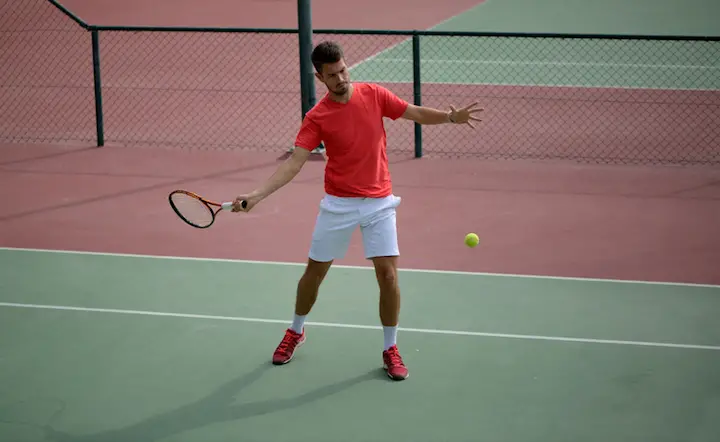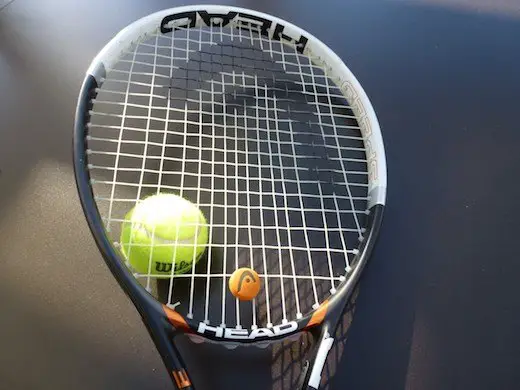- Groundstrokes – low to high extended swings
- Serving – up and over the ball
- Volley – short punch & slight downward motion
Your Guide
 Gavin Davison
Gavin Davison
Tennis is an extremely technical game. In fact, I believe it to be one of the MOST TECHNICALLY CHALLENGING SPORTS in the world.
Of course, other sports, such as golf might be considered just as technical by others, but I’m speaking from my own experience here.

And on the subject of tennis being a very technical sport, one of the MAIN THINGS you have to GRASP as a beginner is how to swing the racket.
Now, with tennis having multiple shots involved in the sport, there isn’t just one answer here, as you can see above.
For GROUNDSTROKES, it’s all about swinging low to high to get that ball LOFTED OVER THE NET.
However, for serving, you want to reach up and hit over the ball as serving is a POWER SHOT!
Then we have volleys, which require an entirely different swing altogether.
Don’t worry, if this seems a lot, I’ve explained each in much greater detail below.
The Different Swing Patterns Explained
If you are concerned about how to swing your racket for DIFFERENT STROKES, I’m going to work from the presumption that you are relatively new to the sport.
Of course, that’s absolutely fine, and I’m pleased you are seeking external help with YOUR GAME!
So on that note, please let me try and explain how to swing the racket for the different strokes in detail:
1) Serving
Serving – this is one of the MOST IMPORTANT shots in tennis.
After all, if you are going to play competitive matches at some point, you will need to serve every other game in singles.
But at this point in your tennis development, there is NO POINT WORRYING about hitting different spins or trying to hit the fluff off the ball.
For now, let’s FOCUS on getting you a consistent serve by developing your understanding of the swing path.
When serving, your aim is to toss the ball up a height that is about AS HIGH AS YOU CAN REACH with your racket in your hand.
Of course, that’s much higher than your head!
So when the ball is at its highest point, you should be swinging up to the ball and then turning your wrist at the top to actually hit over the top of the ball.
This wrist snap is where MUCH OF THE POWER comes from on a SERVE, and a great example would be Roger Federer:
2) Groundstrokes
Groundstrokes describe both the forehand and backhand in tennis.
And once you are involved in a rally, these are the shots that YOU WILL HIT THE MOST.
As you advance in your game, you will start applying different spins in Various Scenarios to get the upper hand.
But all of that will come in good time.
For now, your groundstrokes need CONSISTENCY, and that can be achieved by following a simple low to high swing path.
On both sides, your racket face should be slightly open, meaning that the palm of your hand will be facing upwards as you approach the contact point.
Of course, with the racket face being open, this means that the ball will then go upwards as YOU HIT IT.
After all, you need to clear the NET WITH YOUR SHOTS!
Even as you develop your game and you start to add different spins, this low to high swing path remains the same.
3) Volley
Remember I said volleying is completely different from the other strokes?
I WASN’T LYING!
To be perfectly honest, out of all the strokes I’ve talked about here, it took me the longest to learn how to hit an effective volley.
That’s because the recommended swing path and the way to hit the ball is the COMPLETE OPPOSITE of what you think is true in tennis.
When volleying, you need to have a very short punch on the ball, as that’s how you are able to get the RIGHT CONTROL.
And when you actually ‘swing’ to the ball, the swing path should be horizontal or slightly downwards – depending on the height of the shot you are receiving.
If a ball comes to you at shoulder height, this is where you can have a Slight Downward Motion towards the ball, giving it a nice bite as it hits the court surface on the other side of the net.
But if the ball is waist height or even lower, you can’t swing down to the ball as you’d hit it in the net.
Check out this video to see what I mean:
3) Slice Groundstrokes
On occasion, you may want to use a slice groundstroke to MIX THINGS UP A BIT.
Most players will look to do this on their backhand side, but you can hit slice forehands too if you want.
Now, with a slice backhand, while this is still classed as a groundstroke, the SWING PATH IS DIFFERENT from traditional groundstrokes mentioned earlier.
When you hit a slice, you need to chop down through the ball to keep the TRAJECTORY LOW and MAINTAIN A LOW BOUNCE on the other side.
To achieve this, you should start with your racket up around your shoulders, and then Chop Down and through the shot to get the desired result.
Choosing when to use a slice is the tricky part.
I like to use it as a mix-up to traditional groundstrokes, as well as when approaching the net.
However, other people like to use a slice backhand as a defensive or NEUTRALIZING BALL.
It all depends on who you are playing with and what you feel most comfortable doing.
But regardless of the purpose of your slice backhand, make sure you keep the swing path EXACTLY as described above.
And please – make sure you HIT DOWN THROUGH THE BALL rather than horizontally, as this will reduce the risk of floating your shot into the air.
Did you find this article useful? Feeling more confident with how to swing a tennis racket now? Let us know down below.



